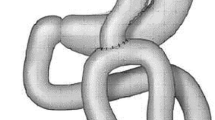Abstract
Background
Although the laparoscopic technique of Roux en Y gastric bypass (LRYGB) has popularized this weight loss procedure, the costs are justifiable if outcomes are superior to the open technique. We report our results with single-incision mini-laparotomy.
Methods
From June 2000 through November 2009, RYGB was performed in 3,300 consecutive patients using a 10–15-cm single-abdominal incision. Established guidelines for patient selection were followed and protocols were developed for patient education and for the prevention of perioperative complications. Weight loss (WL) over time and complications were recorded prospectively. Actual 90-day mortality was compared to that predicted by the Obesity Surgery Mortality Risk Score (OS-MRS).
Results
Eighty-four percent of patients were females with a mean body mass index (BMI) of 50 ± 13. BMI of males was 54 ± 9. There was a normal distribution of the WL response over 2,000 days. Complications included bleeding (1.4%), leak (1%), pulmonary embolism (0.7%), internal hernia (2.5%), and incisional hernia (5.6%). There were 1,793 Class A, 1,288 Class B, and 219 Class C patients. Eleven patients (0.3%) died within 90 days (one Class A, seven Class B, and three Class C), with mortality rates in all classes less than expected by the OS-MRS. Average hospital charges were $13,000.
Conclusions
Our protocols and operative technique should be reproducible in other centers and may have a special appeal, if the costs of LRYGB limit access to bariatric surgery in qualified patients.

Similar content being viewed by others
References
Perioperative safety in the longitudinal assessment of bariatric surgery by the Longitudinal Assessment of Bariatric Surgery (LABS) Consortium. N Engl J Med. 2009;361:445–54.
Schauer PR, Burguera B, Ikramuddin S, et al. Effect of laparoscopic Roux-en Y gastric bypass on type 2 diabetes mellitus. Ann Surg. 2003;238:467–84.
Buchwald H, Avidor Y, Braunwald E, et al. Bariatric surgery: a systematic review and meta-analysis. JAMA. 2004;292:1724–37.
Rasheid S, Banasiak M, Gallagher SF, et al. Gastric bypass is an effective treatment for obstructive sleep apnea in patients with clinically significant obesity. Obes Surg. 2003;13:58–61.
Martin M, Beekley A, Ljorstad R, et al. Socioeconomic disparities in eligibility and access to bariatric surgery: a national population-based analysis. SOARD. 2010;6:8–15.
Caruana JA, Anain PM, Pham DT. The pulmonary embolism risk score system reduces the incidence and mortality of pulmonary embolism after gastric bypass. Surgery. 2009;146:678–83.
DeMaria EJ, Portenier D, Wolfe L. Obesity surgery mortality risk score: proposal for a clinically useful score to predict mortality risk in patients undergoing gastric bypass. SOARD. 2007;3:134–40.
Littell RC, Milliken GA, Stroup WW, et al. SAS system for mixed models. Cary: SAS; 1996.
Weller WE, Rosati C. Comparing outcomes of laparoscopic versus open bariatric surgery. Ann Surg. 2008;248:10–5.
Nguyen NT, Hinojosa M, Faya C, et al. Use and outcomes of laparoscopic versus open gastric bypass at academic medical centers. J Am Coll Surg. 2007;205:248–55.
Podnos YD, Jimenez JC, Wilson SE, et al. Complications after laparoscopic gastric bypass: a review of 3464 cases. Arch Surg. 2003;138:957–61.
Hutter MM, Randall S, Khuri S, et al. Laparoscopic versus open gastric bypass for morbid obesity: a multicenter, prospective, risk-adjusted analysis from the National Surgical Quality Improvement Program. Ann Surg. 2006;243:657–66.
Bessler M, Daud A, DiGiorgi MF, et al. Frequency distribution of weight loss percentage after gastric bypass and adjustable gastric banding. SOARD. 2008;4:486–91.
Dixon JB, McPhail T, O’Brien PE. Minimal reporting requirements for weight loss: current methods not ideal. Obes Surg. 2005;15:1034–9.
Disclosure
Joseph A. Caruana, MD is advisor and shareholder in Info-Surge, Inc. and Bariatric Fusion, Inc. Marc N. McCabe, RPA-C is President and CEO of Bariatric Fusion, Inc. Eran Kabakov, PT is President and CEO of Info-Surge, Inc. There was no outside funding for this work.
Author information
Authors and Affiliations
Corresponding author
Rights and permissions
About this article
Cite this article
Caruana, J.A., McCabe, M.N., Smith, A.D. et al. Roux en Y Gastric Bypass by Single-Incision Mini-Laparotomy: Outcomes in 3,300 Consecutive Patients. OBES SURG 21, 820–824 (2011). https://doi.org/10.1007/s11695-011-0394-1
Published:
Issue Date:
DOI: https://doi.org/10.1007/s11695-011-0394-1




